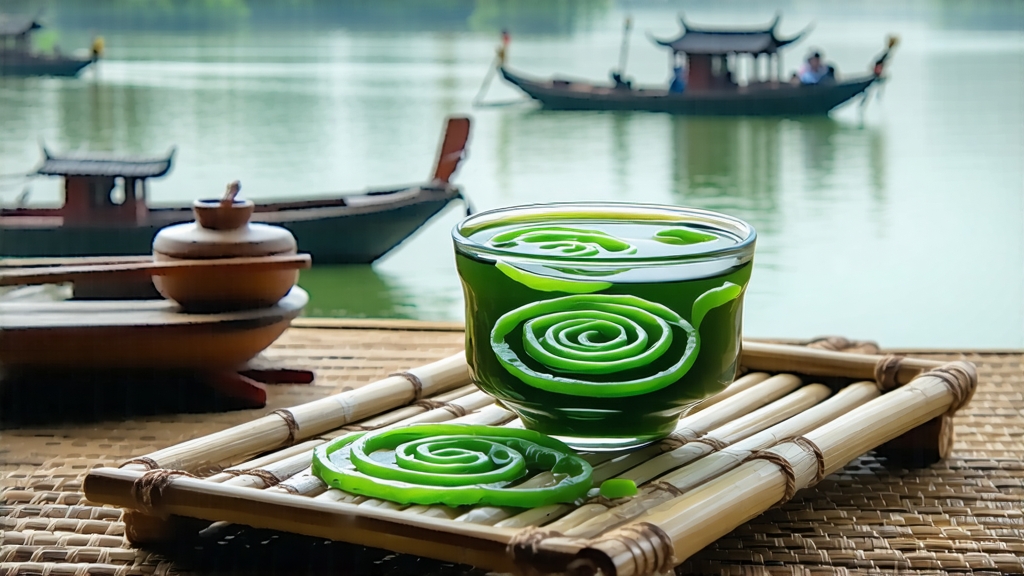
Tucked between the mist-laden hills of Dongting Mountain and the gentle ripples of Taihu Lake in Jiangsu Province, Biluochun—whose name translates literally to “Green Snail of Spring”—has charmed Chinese emperors, poets, and now a growing circle of global tea lovers for more than a thousand years. What appears at first glance to be tiny jade-green snails is in fact one of China’s most celebrated green teas, prized for an almost paradoxical profile: a liquor so soft it feels like silk, yet so fragrant that it once earned the nickname “Scary Fragrance” (Xia Sha Ren Xiang) because pickers swore the aroma startled them in the early mountain hush. This article invites you to journey through the history, terroir, craftsmanship, brewing science, and tasting poetry that define authentic Biluochun.
Historical whispers place Biluochun’s birth during the Tang dynasty (618-907 CE), but its documented fame begins in the late Ming and early Qing when local monks offered it to the Kangxi Emperor during his southern inspection tour. Legend claims that the emperor, struck by the curled shape resembling a snail and the fact that it was picked at the very start of spring, bestowed the poetic name “Bi Luo Chun” (“Green Snail Spring”). From that moment the tea became a tribute item, shipped northward in bamboo-lined chests cushioned with fragrant orange peels to protect the delicate curls and amplify their natural fruity note. European missionaries stationed in Suzhou during the nineteenth century carried small parcels back to Paris and Vienna, where salons nicknamed it “China’s spring perfume,” thus seeding an overseas curiosity that still lingers.
Although Biluochun is officially classified as one green tea, the micro-region nurtures several ecotypes that connoisseurs quietly differentiate. The original “Dongting East & West Mountain” cultivars—Xiao Ye (Small-leaf) and Tu Cha (Local Bush)—remain the most coveted because they absorb the lake’s evaporative humidity, creating an amino-acid density responsible for the tea’s famed sweetness. Around Lake Taihu’s northern rim, newer gardens planted with the Wuniuzao (Sparrow’s Tongue Early) cultivar yield a slightly larger spiral and brighter grassiness, while high-elevation experiments in Zhejiang’s Anji County use the albino Bai Ye cultivar to craft an ivory-green hybrid marketed as “Anji Biluochun,” a gentle nod to the classic style. Each variant carries the trademark spiral, yet the original lake terroir remains the benchmark against which all others are judged.
The crafting of Biluochun is a race against dawn and dew. Picking begins around 5 a.m. in mid-March when air temperature hovers at 10–12 °C and the tender one-bud-one-leaf sets still hold night moisture. Experienced pluckers pinch rather than pull, ensuring the tiny shoot snaps cleanly and remains unbruised. Within thirty minutes the baskets descend to the village alleyways where withering trays await; any delay oxidizes the cuticle and dulls the fragrance. A brief 30-minute solar withering softens cell walls, after which the leaves enter the kill-green (shaqing) wok, traditionally heated to 180 °C by pruning-scented fruit-tree wood. The master’s wrist motion—push, press, shake, roll—lasts exactly six minutes; too short and grassy astringency lingers, too long and the spiral tips burn white. Immediately the leaves are transferred to a bamboo kneading mat where they are rolled into tight spirals while still above 60 °C; this hot-rolling coaxes minute juices to the surface, setting up the glossy sheen that later traps aroma molecules. A final low-temperature bake at 70 °C for twenty minutes reduces moisture to 5 %, locking in the tea’s signature fruity bouquet reminiscent of ripe loquats and white peaches.
Water is the silent ingredient in every cup of Biluochun. Because the leaf is exceptionally delicate, a lower mineral content prevents masking its subtle sweetness. Ideal water measures 40–60 ppm total dissolved solids, pH near 7, and a temperature that never exceeds 80 °C. A 1:50 g/ml ratio—say three grams in a 150 ml glass gaiwan—allows the spirals to expand vertically, a mesmerizing “dancing tea” display.